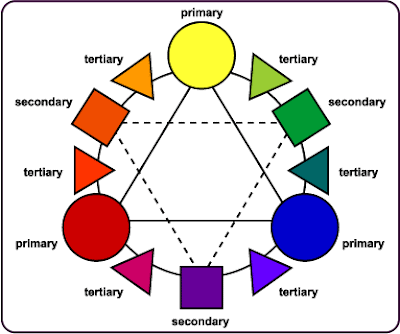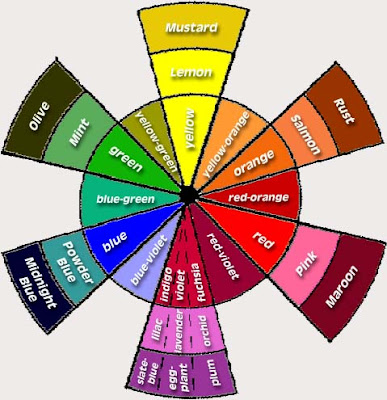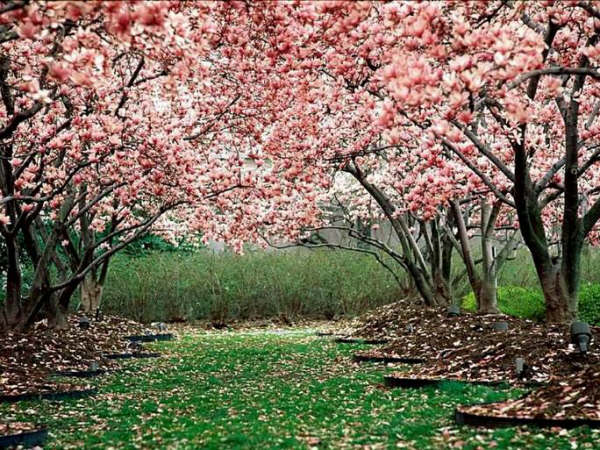All of us know about colors. But how much? Generally everybody knows about the basic colors like Red, Blue, Green, Yellow, Orange, Purple, Violet, Pink, etc. But only a few of us know that the colors extent well beyond these very popular colors. There are so many colors which we are not aware of. This blog is dedicated to the colors that we know and that we don't know much of. Many new colors can be created by mixing of colors. There is actually a color wheel which will make us understand the colors more effectively. There are many color wheels which exist and are accepted. But the color wheel which I'm going to talk about here is the RYB color wheel. These are the colors which many artists use as primary colors for their painting. According to this color wheel Red, Blue and Yellow are the Primary colors and various secondary and tertiary colors can be derived by mixing these colors. Secondary colors are those which can be created by mixing two primary colors together. Tertiary colors are those which can be created by mixing a Primary and a Secondary color together.

The Secondary colors here will be Green, Violet and Orange. And the Tertiary colors are as given below.
Primary, Secondary and Tertiary Colors Apart from these there are various color combinations which can be derived from this particular chart.
Apart from these there are various color combinations which can be derived from this particular chart. This chart shows some hues and Tints of the colors. Hues and Tints are the variations which can be derived from the same color. Ex. Pink is the hue of Red whereas Maroon is the Tint of Red.For those who wonder what is a Hue and a Tint, Hues are the color value of a color when it is mixed with the neutral color white. Tints are the color values of a color when it is mixed with the neutral color Black. Red when mixed with white gives you Pink whereas when mixed with Black it gives Maroon. This can be done with all the colors to get their various Hues and Tints.
This chart shows some hues and Tints of the colors. Hues and Tints are the variations which can be derived from the same color. Ex. Pink is the hue of Red whereas Maroon is the Tint of Red.For those who wonder what is a Hue and a Tint, Hues are the color value of a color when it is mixed with the neutral color white. Tints are the color values of a color when it is mixed with the neutral color Black. Red when mixed with white gives you Pink whereas when mixed with Black it gives Maroon. This can be done with all the colors to get their various Hues and Tints.
Color Schemes:
Now that we have known something about colors we can actually use this information to enrich your homes with your imagination and creativity. Let us see the color schemes and how we can use them to make our homes better.
Analogous colors:Colors next to one another on the color wheel are called analogous (it means "related"). Analogous colors share a common color and usually appear to be in harmony. Ex. Green is made from a mixture of blue and yellow and is therefore analogous to blue and also to yellow.
Complementory Colors:Complementary colors are directly across from one another on the color wheel and share no common colors. Blue and orange are examples of complementary colors.  Based on these color schemes some color harmonies have been developed. But you must be careful in selecting the colors. Some of the color harmonies used at home are.
Based on these color schemes some color harmonies have been developed. But you must be careful in selecting the colors. Some of the color harmonies used at home are.
Monochromatic color Harmony:
A monochromatic scheme consists of different values of one color. 
Also called harmonious colors, are colors that are adjacent to each other on the color wheel. Some examples are green, light green, and yellow or red, orange and yellow.
 Complementary color Harmony:
Complementary color Harmony:Complementary colors are colors that are opposite each other on the color wheel, such as blue and orange, red and green, purple and yellow. These colors, when used side-by-side, make each other appear brighter. When they are mixed, they neutralize each other.
 Split-complementary color Harmony:
Split-complementary color Harmony:A triadic color scheme consists of three colors, such as the basic triad of red, yellow and blue primaries.
 Tetradic color Harmony:
Tetradic color Harmony:Tetrads are any four colors with a logical relationship on the color wheel, such as double complements.

